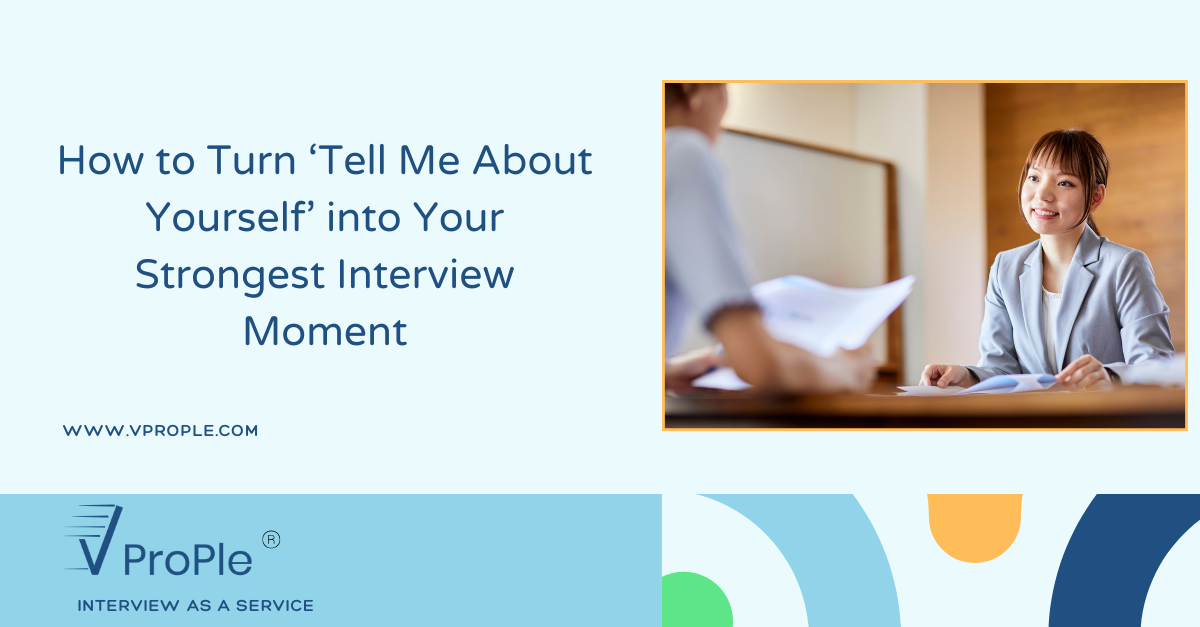This website use cookies to help you have a superior and more relevant browsing experience on the website.
How to Turn ‘Tell Me About Yourself’ into Your Strongest Interview Moment
-
01/11/2025

-by Vishalakshi Muthuraman
Tell Me About Yourself: Every time someone asks, “Tell me about yourself,” I find it oddly fascinating.
It sounds like such a simple question, yet it carries layers. What do they really want to know? Is it what I’ve done, who I am, or what makes me different? Because honestly, what I say about myself always depends on who I’m saying it to and why.
In interviews especially, this question is often treated as a formality, a predictable opener before the “real” questions begin. Most candidates respond with a tidy timeline: education, experience, current role, done.
But that’s where it starts to lose life. There’s no connection, no curiosity just information.
The truth is, talking about ourselves isn’t about reciting milestones; it’s about narrating meaning.
When we think about it, the answer shouldn’t sound like a LinkedIn summary. It should sound like a story, one that begins gently, grows with personality, and ends with a thread that invites curiosity.
Ideally, the conversation should unfold in three layers
First, start simple, something that grounds the listener in who you are and where you come from.
Then, gradually reveal the human side, your intent, your values, your way of thinking.
And finally, leave a spark- a small, intriguing detail that naturally invites the other person to say, “Tell me more about that. That’s where the real magic lies in that fine balance between being too professional and too personal. And that balance, for me, lives in what I call being “propersonal” – professionally personal. When we speak from that space, we sound neither robotic nor reckless, just real.
We’re professionals, yes but with a pulse.
Further Read: Tips to Help You Ace Your Next Panel Interview
So if I were to answer that question today, I’d probably say something like this:
“I began my career as a QA engineer, exploring both new-build and legacy projects. Over time, I realized my work isn’t just about testing systems, it’s about understanding people, patterns, and patience. I enjoy translating complex problems into clean processes, but what really drives me is seeing confidence grow, whether in a release cycle or in a teammate trying something new. And that’s what keeps me curious about what’s next.”
That’s not a résumé.
That’s me, professional, but human.
Because the real goal of “Tell me about yourself” isn’t to finish the question, it’s to start a conversation.
It isn’t just about listing what’s tangible – your degrees, experience, and roles. It’s actually the first narrative hook of your personal brand in an interview. The magic lies in how you move from facts → personality → curiosity trigger – the last one being your bait, the thing that makes the interviewer want to ask more.
The Thought Behind “Tell Me About Yourself”
When someone asks “Tell me about yourself”, they aren’t asking for your life story or résumé in spoken form.
They’re asking: “Who are you, and why should I want to know more about you?”
So while most people answer it mechanically (education → job titles → years of experience), a good communicator uses this question to build connection and spark curiosity.
The response should unfold like a well-paced story:
Start Slow – Establish Ground
A brief professional background that orients the interviewer.
No jargon dump, just enough to anchor the conversation.
Add Character – Humanize It
Subtly highlight your approach, attitude, or values, something that reveals who you are, not just what you do.
This part makes you relatable and authentic.
End with a Bait – Invite Curiosity
A sentence or phrase that hints at something unique about you, such as a project, a turning point, or a personal philosophy.
It acts as a hook, pulling the interviewer into a deeper conversation.
Example Answer (Putting It All Together)
I started my career as a QA engineer about six years ago, right after finishing my computer science degree. Over the years, I’ve worked across both greenfield and brownfield projects, so I’ve seen what it takes to build something from scratch and also how to bring order to legacy chaos.
I’ve always been drawn toward the ‘why’ behind the test, not just the ‘how’, which made me naturally gravitate toward automation and continuous testing frameworks like Playwright and Cypress. I enjoy bridging the gap between technical depth and team collaboration, ensuring testing isn’t an afterthought but a design mindset.
Further Read: Beyond Tell Me About Yourself: Creative Interview Questions That Actually Work
Interestingly, one of my favorite projects wasn’t the biggest or most high-tech. It was when we used a small automation suite to cut test time from 5 hours to 20 minutes. That was the moment I realized how creativity can show up even in testing. It changed how I see the job ever since.”
Why This Works
The first paragraph sets context (basic background, “start slow”).
The second paragraph adds personality and perspective (“shed light on character”).
The third paragraph ends with a hook, a specific story that shows impact and passion (“the bait”).
The interviewer now has a reason to ask, “Tell me more about that project,” or “What do you mean by creativity in testing?” and that’s when you know you’ve captured attention.
Read our latest blog: The Vanishing Act: Why Your Best Candidates Are Ghosting You (And How the Tables Have Turned)
The structure of this conversation determines its impact. A generic, surface-level response makes it a simple icebreaker polite but forgettable. But when the answer flows with intent, from background to character to a subtle hook, it gives the interviewer a direction to start. It transforms a routine question into a guided doorway, setting the tone for curiosity, depth, and meaningful dialogue that reflects who you are beyond your résumé


